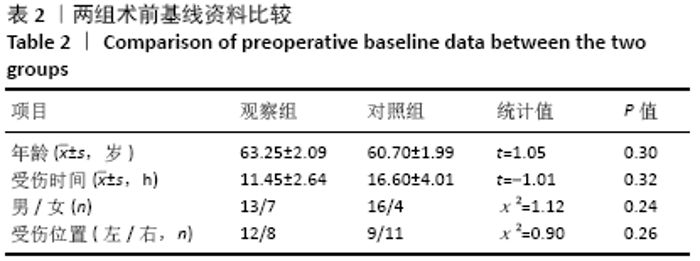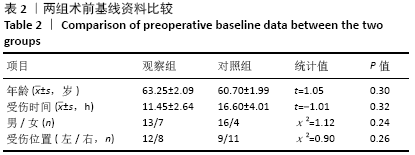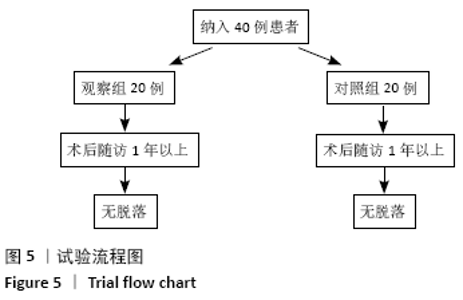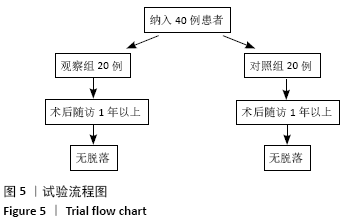Chinese Journal of Tissue Engineering Research ›› 2021, Vol. 25 ›› Issue (18): 2863-2868.doi: 10.3969/j.issn.2095-4344.3829
Previous Articles Next Articles
Difference between proximal humeral locking plate and cannulated screw fixation in the treatment of Mutch type II fracture of greater tuberosity of humerus
Liu Gang1, 2, 3, 4, Zhang Baolu5, Shi Jie1, 2, 3, 4, Bao Dingsu1, 2, 3, 4, Zeng Shengqiang1, 2, 3, 4, Deng Kai1, 2, 3, 4, Liu Yang1, 2, 3, 4, Wang Guoyou1, 2, 3, 4, Fu Shijie1, 2, 3, 4
- 1Department of Orthopedics, 2Center for Orthopedic Diseases Research, Affiliated Traditional Chinese Medicine Hospital of Southwest Medical University, Sichuan Province, China; 3Academician Workstation in Luzhou, Sichuan Province, China; 4Clinical Base of Affiliated Traditional Chinese Medicine Hospital of Southwest Medical University, Guangdong Province Medical 3D Printing Application Transformation Engineering Technology
-
Received:2020-02-28Revised:2020-03-06Accepted:2020-05-09Online:2021-06-28Published:2021-01-12 -
Contact:Fu Shijie, Professor, Chief physician, Department of Orthopedics, and Center for Orthopedic Diseases Research, Affiliated Traditional Chinese Medicine Hospital of Southwest Medical University, Luzhou 646000, Sichuan Province, China; Academician Workstation in Luzhou, Luzhou 646000, Sichuan Province, China; Clinical Base of Affiliated Traditional Chinese Medicine Hospital of Southwest Medical University, Guangdong Province Medical 3D Printing Application Transformation Engineering Technology Research Center, Luzhou 646000, Sichuan Province, China -
About author:Liu Gang, Master, Physician, Department of Orthopedics, and Center for Orthopedic Diseases Research, Affiliated Traditional Chinese Medicine Hospital of Southwest Medical University, Luzhou 646000, Sichuan Province, China; Academician Workstation in Luzhou, Luzhou 646000, Sichuan Province, China; Clinical Base of Affiliated Traditional Chinese Medicine Hospital of Southwest Medical University, Guangdong Province Medical 3D Printing Application Transformation Engineering Technology Research Center, Luzhou 646000, Sichuan Province, China -
Supported by:the Modern Design and Cultural Research Project of Sichuan Provincial Key Research Base of Philosophy and Social Sciences, No. MD18E014 (to LG)
CLC Number:
Cite this article
Liu Gang, Zhang Baolu, Shi Jie, Bao Dingsu, Zeng Shengqiang, Deng Kai, Liu Yang, Wang Guoyou, Fu Shijie. Difference between proximal humeral locking plate and cannulated screw fixation in the treatment of Mutch type II fracture of greater tuberosity of humerus[J]. Chinese Journal of Tissue Engineering Research, 2021, 25(18): 2863-2868.
share this article
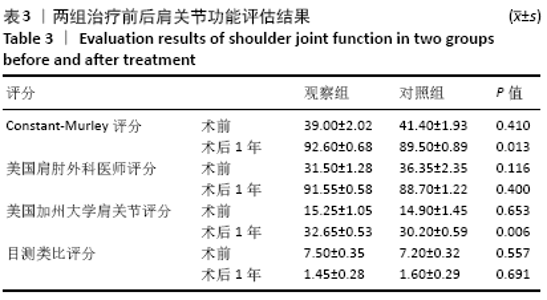
2.4 两组术后影像学检查结果 40例患者术后第2天行X射线片检查,显示钢板与空心螺钉角度、位置良好,未见植入物松动,未见关节周围二次骨折,无周围血管、神经损伤。 2.5 生物相容性 40例患者出院后定期门诊随访并行X射线片复查,在术后随访1年的过程中均未出现钢板或螺钉松动、折断、感染或排斥等并发症,其中观察组出现1例大结节畸形愈合,1例肩关节疼痛;对照组3例大结节畸形愈合,2例大结节上移,2例肩关节疼痛。所有内植物在术后1年随访时间内均无排斥及感染等不良反应事件,后期不良反应在进一步随访中。 2.6 两组临床功能评估结果 治疗前,两组CMS评分、ASES评分、UCLA评分、目测类比评分比较差异均无显著性意义 (P > 0.05);术后随访1年时,观察组CMS评分、UCLA评分高于对照组(P < 0.05),两组间ASES评分、目测类比评分比较差异无显著性意义(P > 0.05),见表3。"
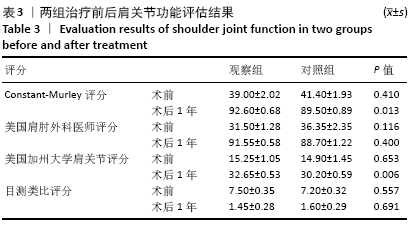
| [1] ROULEAU DM, MUTCH J, LAFLAMME GY, et al. Surgical Treatment of Displaced Greater Tuberosity Fractures of the Humerus. J Am Acad Orthop Surg. 2016;24(1):46-56. [2] SHI X, LIU H, XING R, et al. Effect of intramedullary nail and locking plate in the treatment of proximal humerus fracture:an update systematic review and meta-analysis. J Orthop Surg Res. 2019;14(1):285. [3] KIM SH, SZABO RM, MARDER RA. Epidemiology of humerus fractures in the United States: nationwide emergency department sample, 2008. Arthritis Care Res. 2012;64(3):407-414. [4] LAUNONEN AP, LEPOLA V, SARANKO A, et al. Epidemiology of proximal humerus fractures. Arch Osteoporos. 2015;10:209. [5] MAMAN E, DOLKART O, CHECHIK O, et a1. Arthroscopic findings of coexisting lesions with greater tuberosity fractures. Orthopedics. 2014;37(3):e272-277. [6] DEBOTTIS D,ANAVIAN J,GREEN A.Surgical Management of Isolated Greater Tuberosity Fractures of the Proximal Humerus.Orthop Clin North Am.2014;45(2):207-218. [7] LILL H,KATTHAGEN C,JENSEN G,et al.Arthroscopic fracture management in proximal humeral fractures. Unfallchirurg.2013;116(4):296-304. [8] TAVERNA E, SANSONE V, BATTISTELLA F, et al. Arthroscopic treatment for greater tuberosity fractures: rationale and surgical technique. Arthroscopy. 2004;20(6):e53-57. [9] GEORGE MS. Fractures of the greater tuberosity of the humerus. J Am Acad Orthop Surg. 2007;15:607-613. [10] GREEN A, IZZI J JR. Isolated fractures of the greater tuberosity of the proximal humerus. J Shoulder Elbow Surg. 2003;12:641-649. [11] PLATZER P, KUTSCHA-LISSBERG F, LEHR S, et al. The influence of displacement on shoulder function in patients with minimally displaced fractures of the greater tuberosity. Injury. 2005;36:1185-1189. [12] BHATIA DN, VAN ROOYEN KS, DU TOIT DF, et al. Surgical treatment of comminuted, displaced fractures of the greater tuberosity of the proximal humerus: a new technique of double-row suture-anchor fixation and long-term results. Injury. 2006;37:946-952. [13] NEER CS 2ND. Displaced proximal humeral fractures. I. Classification and evaluation. J Bone Joint Surg Am. 1970;52(6):1077-1089. [14] SWARUP I, HUGHES MS, BRAM JT, et al. Percutaneous Pinning of Pediatric Proximal Humeral Fractures. JBJS Essent Surg Tech. 2019;9(4):e33.1-6. [15] SUN Q, GE W, LI G, et al. Locking plates versus intramedullary nails in the management of displaced proximal humeral fractures: a systematic review and meta-analysis. Int Orthop. 2018;42(3):641-650. [16] KUMAR V, DATIR S, VENKATESWARAN B. Intramedullary Nailing for Displaced Proximal Humeral Fractures. J Orthop Surg. 2010;18(3):324-327. [17] CAROFINO BC, LEOPOLD SS. Classifications in brief: the Neer classification for proximal humerus fractures. Clin Orthop Relat Res. 2013;471(1):39-43. [18] KORNER J, LILL H, MÜLLER LP, et al. Distal humerus fractures in elderly patients: results after open reduction and internal fixation. Osteoporos Int. 2005;16(2):S73-79. [19] MUTCH J, LAFLAMME GY, HAGEMEISTER N, et al. A new morphological classification for greater tuberosity fractures of the proximal humerus: validation and clinical implications. Bone Joint J. 2014;96(5):646-651. [20] GUMINA S, GIANNICOLA G, ALBINO P, et al. Comparison between two classifications of humeral head fractures: Neer and AO-ASIF. Acta Orthop Belg. 2011;77(6):751-757. [21] LEVY DM, ERICKSON BJ, HARRIS JD, et al. Management of Isolated Greater Tuberosity Fractures: A Systematic Review. Am J Orthop. 2017; 46(6):E445-E453. [22] LEVINE B, PEREIRA D, ROSEN J. Avulsion Fractures of the Lesser Tuberosity of the Humerus in Adolescents: Review of the Literature and Case Report. J Orthop Trauma. 2005;19(5):349-352 [23] KAVURI V, BOWDEN B, KUMAR N, et al .Complications Associated with Locking Plate of Proximal Humerus Fractures. Indian J Orthop. 2018; 52(2):108-116. [24] KONRAD G, BAYER J, HEPP P, et al. Open Reduction and Internal Fixation of Proximal Humeral Fractures with Use of the Locking Proximal Humerus Plate. J Bone Joint Surg Am. 2010;92:85-95. [25] JABRAN A, PEACH C, REN L. Biomechanical analysis of plate systems for proximal humerus fractures: a systematic literature review. Biomed Eng Online. 2018;17(1):47. [26] BORER J, SCHWARZ J, POTTHAST S, et al. Mid-term results of minimally invasive deltoid-split versus standard open deltopectoral approach for PHILOS™ (proximal humeral internal locking system) osteosynthesis in proximal humeral fractures. Eur J Trauma Emerg Surg. 2020;46(4): 825-834. [27] ANGST F, GOLDHAHN J, DRERUP S, et al. Responsiveness of six outcome assessment instruments in total shoulder arthroplasty. Arthritis Rheum. 2008;59(3):391-398. [28] MALAVOLTA EA, ASSUNÇÃO JH, GRACITELLI MEC, et al. Correlation between the UCLA and Constant-Murley scores in rotator cuff repairs and proximal humeral fractures osteosynthesis. Rev Bras Ortop. 2018; 53(4):441-447. [29] XU S, CHEN JY, LIE HME, et al. Minimal Clinically Important Difference of Oxford,Constant,and UCLA shoulder score for arthroscopic rotator cuff repair. J Orthop. 2020;19:21-27. [30] ASSUNÇÃO JH, MALAVOLTA EA, GRACITELLI MEC, et al. Clinical outcomes of arthroscopic rotator cuff repair: correlation between the University of California, Los Angeles and American Shoulder and Elbow Surgeons scores. J Shoulder Elbow Surg. 2017;26(7):1137-1142. [31] 周建波.肩关节骨性结构与肩袖损伤的相关性研究[D].重庆:第三军医大学,2011. [32] TISCHER T, VOGT S, KREUZ PC, et al. Arthroscopic Anatomy,Variants, and Pathologic Findings in Shoulder Instability. Arthroscopy. 2011; 27(10):1434-1443 [33] WHITE EA, SKALSKI MR, PATEL DB, et al. Isolated greater tuberosity fractures of the proximal humerus: anatomy, injury patterns, multimodality imaging, and approach to management. Emerg Radiol. 2018;25(5):1-12. [34] OGAWA K, YOSHIDA A, IKEGAMI H. Isolated Fractures of the Greater Tuberosity of the Humerus: Solutions to Recognizing a Frequently Overlooked fracture. J Trauma. 2003;54(4):713-717. [35] JANSSEN SJ, HERMANUSSEN HH, GUITTON TG, et al. Greater Tuberosity Fractures: Does Fracture Assessment and Treatment Recommendation Vary Based on Imaging Modality? Clin Orthop Relat Res. 2016;474(5):1257-1265. [36] NAGGAR L. Surgical Management of Comminuted, Displaced Greater Tuberosity Fractures: A New Technique of Subacromial Spacer on Top of Double-Row Suture Anchor Fixation. Joints. 2018;6(3):211-214. [37] LILL H, KATTHAGEN C, JENSEN G, et al. Arthroscopic fracture management in proximal humeral fractures. Unfallchirurg. 2013;116(4):296-304. [38] SAKAMOTO Y, KIDO A, INOUE K, et al. In vivo microstructural analysis of the humeral greater tuberosity in patients with rotator cuff tears using multidetector row computed tomography. BMC Musculoskelet Disord.2 014;15(1):351. [39] GAUDELLI C, MÉNARD J, MUTCH J, et al. Locking plate fixation provides superior fixation of humerus split type greater tuberosity fractures than tension bands and double row suture bridges. Clin Biomech. 2014;29(9):1003-1008. [40] 张德刚,孙建云,王兆林,等.三种植入物固定劈裂型肱骨大结节骨折的生物力学分析[J].中国组织工程研究,2019,23(36):5806-5810. [41] PARK SE, JEONG JJ, PANCHAL K, et al. Arthroscopic-assisted plate fixation for displaced large-sized comminuted greater tuberosity fractures of proximal humerus: a novel surgical technique. Knee Surg Sports Traumatol Arthrosc. 2016;24(12):3892-3898. [42] ALI J, CHRIS P, ZHENMIN Z, et al. Biomechanical comparison of screw-based zoning of PHILOS and Fx proximal humerus plates. BMC Musculoskelet Disord. 2018;19(1):253. [43] CIRIC D, MISCHLER D, QAWASMI F, et al. Secondary perforation risk in plate osteosynthesis of unstable proximal humerus fractures: a biomechanical investigation of the effect of screw length. J Orthop Res. 2019;37(12):2625-2633. [44] RÖDERER G, SCOLA A, SCHMÖLZ W, et al. Biomechanical in vitro assessment of screw augmentation in locked plating of proximal humerus fractures. Injury. 2013;44(10):1327-1332. [45] RICCHETTI ET, WARRENDER WJ, ABBOUD JA. Use of locking plates in the treatment of proximal humerus fractures. J Shoulder Elbow Surg. 2010;19(2):66-75. [46] WANG H, RUI B, LU S, et al. Locking Plate Use with or without Strut Support for Varus Displaced Proximal Humeral Fractures in Elderly Patients. JBJS Open Access. 2019;4(3):e0060.1-8. [47] SOHN HS, SHIN SJ. Modified use of a proximal humeral internal locking system (PHILOS) plate in extra-articular distal-third diaphyseal humeral fractures. Injury. 2019;50(7):1300-1305. [48] OWSLEY KC, GORCZYCA JT. Fracture displacement and screw cutout after open reduction and locked plate fixation of proximal humeral fractures. J Bone Joint Surg Am. 2008;90(2):233-240. [49] 张学东,毛勇,王海龙,等.微创肱骨近端锁定接骨板与空心钉内固定治疗肱骨大结节劈裂骨折疗效比较[J].中国骨与关节损伤杂志,2017,32(5):533-535. [50] HÉBERT-DAVIES J, MUTCH J, ROULEAU D, et al. Delayed Migration of Greater Tuberosity Fractures Associated With Anterior Shoulder Dislocation. J Orthop Trauma. 2015;29:e396-400. |
| [1] | Xu Feng, Kang Hui, Wei Tanjun, Xi Jintao. Biomechanical analysis of different fixation methods of pedicle screws for thoracolumbar fracture [J]. Chinese Journal of Tissue Engineering Research, 2021, 25(9): 1313-1317. |
| [2] | Jiang Yong, Luo Yi, Ding Yongli, Zhou Yong, Min Li, Tang Fan, Zhang Wenli, Duan Hong, Tu Chongqi. Von Mises stress on the influence of pelvic stability by precise sacral resection and clinical validation [J]. Chinese Journal of Tissue Engineering Research, 2021, 25(9): 1318-1323. |
| [3] | Zhang Tongtong, Wang Zhonghua, Wen Jie, Song Yuxin, Liu Lin. Application of three-dimensional printing model in surgical resection and reconstruction of cervical tumor [J]. Chinese Journal of Tissue Engineering Research, 2021, 25(9): 1335-1339. |
| [4] | Zhang Yu, Tian Shaoqi, Zeng Guobo, Hu Chuan. Risk factors for myocardial infarction following primary total joint arthroplasty [J]. Chinese Journal of Tissue Engineering Research, 2021, 25(9): 1340-1345. |
| [5] | Wei Wei, Li Jian, Huang Linhai, Lan Mindong, Lu Xianwei, Huang Shaodong. Factors affecting fall fear in the first movement of elderly patients after total knee or hip arthroplasty [J]. Chinese Journal of Tissue Engineering Research, 2021, 25(9): 1351-1355. |
| [6] | Wang Jinjun, Deng Zengfa, Liu Kang, He Zhiyong, Yu Xinping, Liang Jianji, Li Chen, Guo Zhouyang. Hemostatic effect and safety of intravenous drip of tranexamic acid combined with topical application of cocktail containing tranexamic acid in total knee arthroplasty [J]. Chinese Journal of Tissue Engineering Research, 2021, 25(9): 1356-1361. |
| [7] | Xiao Guoqing, Liu Xuanze, Yan Yuhao, Zhong Xihong. Influencing factors of knee flexion limitation after total knee arthroplasty with posterior stabilized prostheses [J]. Chinese Journal of Tissue Engineering Research, 2021, 25(9): 1362-1367. |
| [8] | Huang Zexiao, Yang Mei, Lin Shiwei, He Heyu. Correlation between the level of serum n-3 polyunsaturated fatty acids and quadriceps weakness in the early stage after total knee arthroplasty [J]. Chinese Journal of Tissue Engineering Research, 2021, 25(9): 1375-1380. |
| [9] | Zhang Chong, Liu Zhiang, Yao Shuaihui, Gao Junsheng, Jiang Yan, Zhang Lu. Safety and effectiveness of topical application of tranexamic acid to reduce drainage of elderly femoral neck fractures after total hip arthroplasty [J]. Chinese Journal of Tissue Engineering Research, 2021, 25(9): 1381-1386. |
| [10] | Wang Haiying, Lü Bing, Li Hui, Wang Shunyi. Posterior lumbar interbody fusion for degenerative lumbar spondylolisthesis: prediction of functional prognosis of patients based on spinopelvic parameters [J]. Chinese Journal of Tissue Engineering Research, 2021, 25(9): 1393-1397. |
| [11] | Lü Zhen, Bai Jinzhu. A prospective study on the application of staged lumbar motion chain rehabilitation based on McKenzie’s technique after lumbar percutaneous transforaminal endoscopic discectomy [J]. Chinese Journal of Tissue Engineering Research, 2021, 25(9): 1398-1403. |
| [12] | Chen Xinmin, Li Wenbiao, Xiong Kaikai, Xiong Xiaoyan, Zheng Liqin, Li Musheng, Zheng Yongze, Lin Ziling. Type A3.3 femoral intertrochanteric fracture with augmented proximal femoral nail anti-rotation in the elderly: finite element analysis of the optimal amount of bone cement [J]. Chinese Journal of Tissue Engineering Research, 2021, 25(9): 1404-1409. |
| [13] | Du Xiupeng, Yang Zhaohui. Effect of degree of initial deformity of impacted femoral neck fractures under 65 years of age on femoral neck shortening [J]. Chinese Journal of Tissue Engineering Research, 2021, 25(9): 1410-1416. |
| [14] | Zhang Shangpu, Ju Xiaodong, Song Hengyi, Dong Zhi, Wang Chen, Sun Guodong. Arthroscopic suture bridge technique with suture anchor in the treatment of acromioclavicular dislocation [J]. Chinese Journal of Tissue Engineering Research, 2021, 25(9): 1417-1422. |
| [15] | Liang Yan, Zhao Yongfei, Xu Shuai, Zhu Zhenqi, Wang Kaifeng, Liu Haiying, Mao Keya. Imaging evaluation of short-segment fixation and fusion for degenerative lumbar scoliosis assisted by highly selective nerve root block [J]. Chinese Journal of Tissue Engineering Research, 2021, 25(9): 1423-1427. |
| Viewed | ||||||
|
Full text |
|
|||||
|
Abstract |
|
|||||
